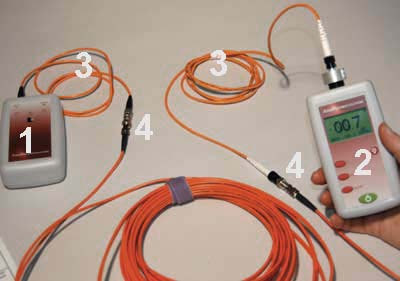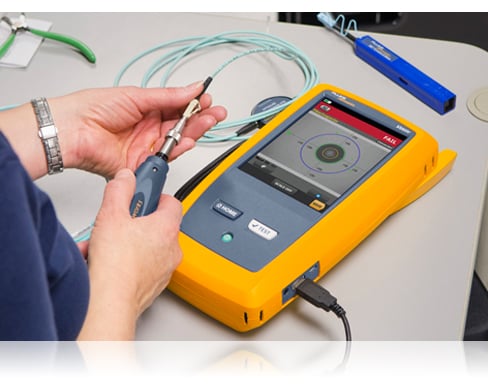Vital Functions to Seek in Optical Fiber Screening Equipment
When evaluating optical fiber screening devices, a number of necessary functions call for cautious consideration to guarantee optimal performance and reliability. Trick features such as precision, accuracy, and easy to use interfaces play an important function in effective measurement and convenience of usage. In addition, the value of mobility and sturdiness can not be overemphasized, especially for on-site applications. Compatibility with existing industry criteria improves performance, while advanced dimension abilities, including TDR and OTDR screening, deal crucial insights right into network integrity. Understanding these functions will lose light on exactly how to choose the appropriate devices for your specific demands. What elements might you focus on?
Accuracy and Precision
Precision and accuracy are vital criteria in the evaluation of optical fibre screening tools. These two features ensure that measurements show the real efficiency of fiber optic systems, which is vital for effective network setup, maintenance, and troubleshooting. Precision describes the distance of a measured value to the real worth, while precision signifies the repeatability of dimensions under unchanged problems.
When selecting optical fibre screening tools, it is important to think about tools that supply high accuracy and precision to reduce mistakes in information analysis. Devices such as optical time-domain reflectometers (OTDRs) and power meters must have calibration systems to ensure consistent performance in time. Furthermore, the specs offered by makers must information the devices's dimension unpredictability, which straight affects the dependability of examination results.
Additionally, the performance of optical fibre testing equipment can be affected by environmental factors, such as temperature and humidity. As a result, selecting equipment designed to mitigate these variables will certainly boost measurement integrity. In verdict, buying optical fibre testing tools with durable accuracy and accuracy attributes is essential for maintaining optimal network efficiency and making certain the honesty of fibre optic interactions.

User-Friendly Interface
The performance of optical fibre screening equipment is not exclusively determined by its accuracy and accuracy; an easy to use user interface plays a significant duty in improving functional performance. A properly designed user interface simplifies the communication between the professional and the equipment, permitting a much more instinctive understanding of complex functions.
Secret functions of a straightforward interface include clear navigating food selections, logical designs, and quickly obtainable controls. These elements enable professionals to perform tests quickly without considerable training, reducing the possibility of individual mistake - ofda. Visual indicators such as progress bars, notifies, and visual representations of information can dramatically boost the user experience by providing immediate feedback on the screening procedure.
Furthermore, adjustable settings can even more improve procedures by permitting customers to readjust criteria according to details screening requirements. This flexibility not just conserves time however also guarantees that the devices meets diverse application needs.
Integrating aid functions, such as tooltips and detailed manuals, right into the interface can better equip users, advertising self-sufficiency and confidence in running the equipment. Eventually, an easy to use interface is necessary for taking full advantage of the potential of optical fiber screening tools, resulting in extra efficient and efficient screening outcomes.
Mobility and Durability
Mobility and toughness are essential qualities of optical fiber screening equipment, guaranteeing next that it can stand up to the roughness of various atmospheres while staying very easy to transportation. Specialists typically function in varied setups, from telecoms centers to remote installations, making it imperative that testing devices are light-weight and portable (ofda). Equipment designed with portability in mind typically features ergonomic manages and instances that help with uncomplicated activity, thus enhancing operational efficiency on-site
Resilience is equally important, as optical fibre testing equipment is frequently subjected to extreme problems, consisting of temperature level variations, moisture, and physical impacts. Tools constructed with sturdy products such as enhanced plastics or steel housings are better matched for these settings, decreasing the danger of damage during use and transportation. In addition, devices with water and dust resistance ratings, such as IP rankings, makes certain trusted efficiency in difficult conditions.
Compatibility With Specifications
Guaranteeing compatibility with market standards is vital for optical fibre testing devices, as it directly impacts the reliability and legitimacy of test outcomes. Optical fiber networks go through strict efficiency criteria developed by different companies, consisting of the Telecommunications Market Organization (TIA) and the International Electrotechnical Commission (IEC) Evaluating tools must comply with these requirements to make certain that dimensions correspond and similar across different systems and settings.
When selecting optical fiber screening devices, fibre testing equipment users should validate that the tool fulfills appropriate requirements relevant to their certain application, such as those pertaining to attenuation, data transfer, and crosstalk. Tools that is certified with established standards not just helps in accomplishing precise outcomes however also assists in interoperability amongst tools from various makers.
Additionally, compatibility with criteria makes sure that the tools can be utilized in governing compliance scenarios, which is crucial for tasks in markets such as telecommunications, aerospace, and army applications. As a result, spending in optical fibre screening equipment that aligns with existing market requirements is a fundamental element of preserving high quality assurance and accomplishing optimal network performance.
Advanced Measurement Capabilities
Advanced measurement abilities are a specifying function of modern-day optical fibre screening equipment, allowing for thorough analysis of network performance. These capabilities ensure that specialists can review important parameters such as signal loss, diffusion, and data transfer, which are essential for maintaining ideal interaction performance.
One trick element is the capability to perform time-domain reflectometry (TDR) and optical time-domain reflectometry (OTDR) examinations. These strategies enable individuals to determine mistakes, gauge the length of fibres, and figure out the location of problems with remarkable precision - ofda. Advanced devices commonly consists of the ability to gauge optical power levels, helping to analyze the overall health of the network and make certain conformity with the called for specifications.
Furthermore, some testing devices offer innovative algorithms for real-time analysis, making it possible for quicker diagnosis and troubleshooting. This is specifically vital in high-speed networks where downtime can cause significant monetary losses. With the combination of sophisticated software program user interfaces, customers can imagine information better, promoting educated decision-making. Finally, purchasing optical fiber screening equipment with innovative measurement capabilities is crucial for guaranteeing network dependability and performance in today's demanding telecoms landscape.
Conclusion

Comments on “Cutting-Edge Fibre Testing Equipment for Field and Field Use”